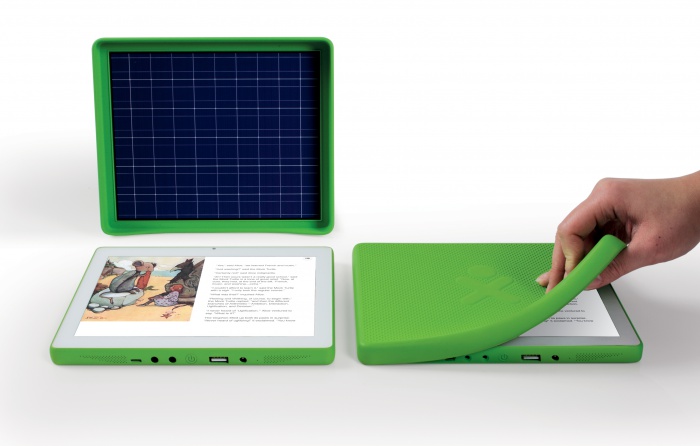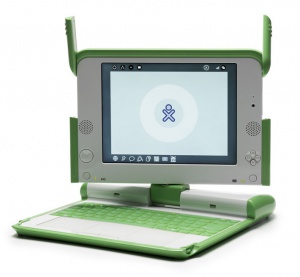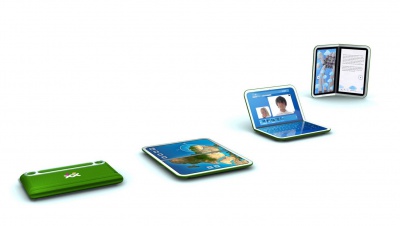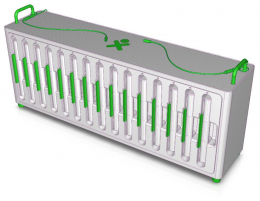Hardware: Difference between revisions
m (→XO-3 Tablet) |
No edit summary |
||
| Line 10: | Line 10: | ||
# Robust and Maintainable -- children drop things |
# Robust and Maintainable -- children drop things |
||
# Performance (speed) |
# Performance (speed) |
||
| ⚫ | |||
| ⚫ | |||
| ⚫ | |||
| ⚫ | |||
| ⚫ | |||
==Laptops== |
==Laptops== |
||
| Line 55: | Line 65: | ||
'''XO-1.75 Versions:''' ''Not in production''; ''CL2 pre-production models are:'' [[XO_1.75_C1|C1]], [[XO_1.75_B1|B1]], [[XO_1.75_A3|A3]], [[XO_1.75_A2|A2]], [[XO_1.75_A1|A1]] |
'''XO-1.75 Versions:''' ''Not in production''; ''CL2 pre-production models are:'' [[XO_1.75_C1|C1]], [[XO_1.75_B1|B1]], [[XO_1.75_A3|A3]], [[XO_1.75_A2|A2]], [[XO_1.75_A1|A1]] |
||
== |
==Ideas== |
||
None of these have ever seen more than sample production. |
|||
| ⚫ | |||
| ⚫ | |||
| ⚫ | |||
| ⚫ | |||
| ⚫ | |||
===XO-2 Foldable Tablet=== |
===XO-2 Foldable Tablet=== |
||
| Line 74: | Line 77: | ||
<br clear="all"> |
<br clear="all"> |
||
==XS School Server== |
===XS School Server=== |
||
[[Image:XS_floor_diag.png|100px| |
[[Image:XS_floor_diag.png|100px|left]] |
||
While the laptop is rightfully at the center of OLPC, a valuable peripheral is the [[School_server|school server]]. Recognizing this, OLPC designed a [[School server]] to extend the storage and computation provided by each laptop, as well as providing a local library and a mesh portal to the Internet. But this is more of a [[XS_Server_Services|collection of services]] than a hardware platform. Unlike the laptop, which has a well defined user load (one child), the [[School_server|school server]] is designed to serve an entire school, whose sizes vary greatly. Thus a variety of hardware solutions is necessary. Thankfully, an entire industry is available serving this hardware need, at a variety of price and power levels from small fanless systems to desktop PCs to large servers. For example, small and mid-sized schools should be well served by this [[XS_Recommended_Hardware|recommended hardware]]. |
While the laptop is rightfully at the center of OLPC, a valuable peripheral is the [[School_server|school server]]. Recognizing this, OLPC designed a [[School server]] to extend the storage and computation provided by each laptop, as well as providing a local library and a mesh portal to the Internet. But this is more of a [[XS_Server_Services|collection of services]] than a hardware platform. Unlike the laptop, which has a well defined user load (one child), the [[School_server|school server]] is designed to serve an entire school, whose sizes vary greatly. Thus a variety of hardware solutions is necessary. Thankfully, an entire industry is available serving this hardware need, at a variety of price and power levels from small fanless systems to desktop PCs to large servers. For example, small and mid-sized schools should be well served by this [[XS_Recommended_Hardware|recommended hardware]]. |
||
| Line 82: | Line 85: | ||
<br clear="all"> |
<br clear="all"> |
||
==Peripherals== |
|||
In addition to the laptops and handbooks, there are some peripheral hardware components in whose design OLPC is involved. |
|||
===Multichannel battery charger=== |
===Multichannel battery charger=== |
||
| Line 96: | Line 96: | ||
===Active Antenna=== |
===Active Antenna=== |
||
[[Image:AA-tilted.jpg|100px| |
[[Image:AA-tilted.jpg|100px|left]] |
||
The [[Active Antenna]] is the same Marvell radio used in the XO-1 laptop, but on a 5m USB cable allowing their use either standalone (with a power supply) or with a [[School server]]. ''Unfortunately, Active Antenna production is awaiting the development of a better mesh implementation for dense mesh situations. We currently recommend the use of traditional 802.11b/g access points with the XO.'' |
The [[Active Antenna]] is the same Marvell radio used in the XO-1 laptop, but on a 5m USB cable allowing their use either standalone (with a power supply) or with a [[School server]]. ''Unfortunately, Active Antenna production is awaiting the development of a better mesh implementation for dense mesh situations. We currently recommend the use of traditional 802.11b/g access points with the XO.'' |
||
Revision as of 05:47, 3 February 2012
One Laptop Per Child believes that innovative design is capable of bringing robust computing to children in the developing world at low power and low cost. This began with the XO laptop, and continues with the second generation handbook and peripherals.
Unlike traditional computer manufacturers, the design goals of OLPC are (in order):
- Safe -- no children should be harmed
- Stylish and Usable -- something children want to own
- Lowest Power -- low power means longer run-time
- Lowest Cost -- a lower cost means more children can have one
- Robust and Maintainable -- children drop things
- Performance (speed)
XO-3 Tablet
- Main page: XO-3
OLPC is currently developing a low cost, low power, robust tablet for use by kids.
XO-3 Versions: Not in production yet; CL3 pre-production models are: A1
Laptops
XO Laptop
The XO Laptop is the most rugged low power, low cost laptop currently available.
- The Children's Laptop
- Why it is unique
- Keyboard
- Display
- Batteries (Battery Charging)
- Certifications (Safety and RF emissions)
- Environmental Impact (The Green Machine)
- Troubleshooting the laptop
- User modifications of the laptop
XO-1 Laptop
This was the original XO laptop, of which over a million were manufactured. Production of the XO-1 stopped in Spring 2010.
XO-1 Versions: Two models entered production: XO CL1A, CL1; CL1 pre-production models were: C1, B4, B3, B2, B1, A1
- Details of the XO-1 laptop hardware
- The definitive laptop specification (only available in PDF format).
While developing the XO, many ideas for hardware were contributed.
XO-1.5 Laptop
A refresh of the XO-1 laptop happened in 2009. In a continued effort to maintain a low price point, OLPC refreshed the laptop electronics to use the latest component technologies. This refresh (Gen 1.5) is separate from the Gen 2/3 projects, and continue to use the same industrial design and batteries as Gen 1. This provides an overall update of the system within the same ID and external appearance, giving school systems using the XO-1 with a cost effective replacement.
- Details of the XO-1.5 hardware
- Hardware brief (pdf)
- The definitive hardware specification (only available in PDF)
- Announcement, April 17, 2009
XO-1.5 Versions: Production: CL1B C5, CL1B C3, CL1B C2, ; CL1B pre-production models are: C1, B3, B2, B1, A2, A1
XO-1.75 Laptop
- Main page: XO-1.75
In 2010, OLPC started development of a laptop based around an ARM processor, in order to finally reach an operating power low enough to allow a full day of operation from a single battery charge, as well as better operation from solar and human energy sources. This refresh (Gen 1.75) continues to use the same industrial design, display, and batteries as Gen 1.
XO-1.75 Versions: Not in production; CL2 pre-production models are: C1, B1, A3, A2, A1
Ideas
None of these have ever seen more than sample production.
XO-2 Foldable Tablet
In May of 2008, plans for the next generation of OLPC laptops were publicly announced. Nicholas Negroponte challenged the design team to aim for those goals while also rethinking the notion of a laptop. The result doesn't fit neatly into the "laptop" category. The form factor is that of a book or folded (clam shell) tablet --- a handbook. At this time, development of this device has been halted in favor of a more conventional tablet, the XO-3.
XS School Server
While the laptop is rightfully at the center of OLPC, a valuable peripheral is the school server. Recognizing this, OLPC designed a School server to extend the storage and computation provided by each laptop, as well as providing a local library and a mesh portal to the Internet. But this is more of a collection of services than a hardware platform. Unlike the laptop, which has a well defined user load (one child), the school server is designed to serve an entire school, whose sizes vary greatly. Thus a variety of hardware solutions is necessary. Thankfully, an entire industry is available serving this hardware need, at a variety of price and power levels from small fanless systems to desktop PCs to large servers. For example, small and mid-sized schools should be well served by this recommended hardware.
There is a persistent need for a low cost, robust server solution for environmentally extreme and low power situations (jungles/salt water). OLPC designed a low cost XS server (pictured) with sealed operation up to 50C. Unfortunately, it is still looking for a manufacturer.
Multichannel battery charger
Classroom situations, especially those without "grid" power, are challenging for powering laptops. One of the solutions is a multiple battery charger, which allows a number of laptop batteries to be charged in a small cabinet taking AC or 12VDC input.
OLPC has pursued the design of a Multi-Battery Charger for the XO Laptop, and has units entering safety testing in Jan. 2008.
Active Antenna
The Active Antenna is the same Marvell radio used in the XO-1 laptop, but on a 5m USB cable allowing their use either standalone (with a power supply) or with a School server. Unfortunately, Active Antenna production is awaiting the development of a better mesh implementation for dense mesh situations. We currently recommend the use of traditional 802.11b/g access points with the XO.





